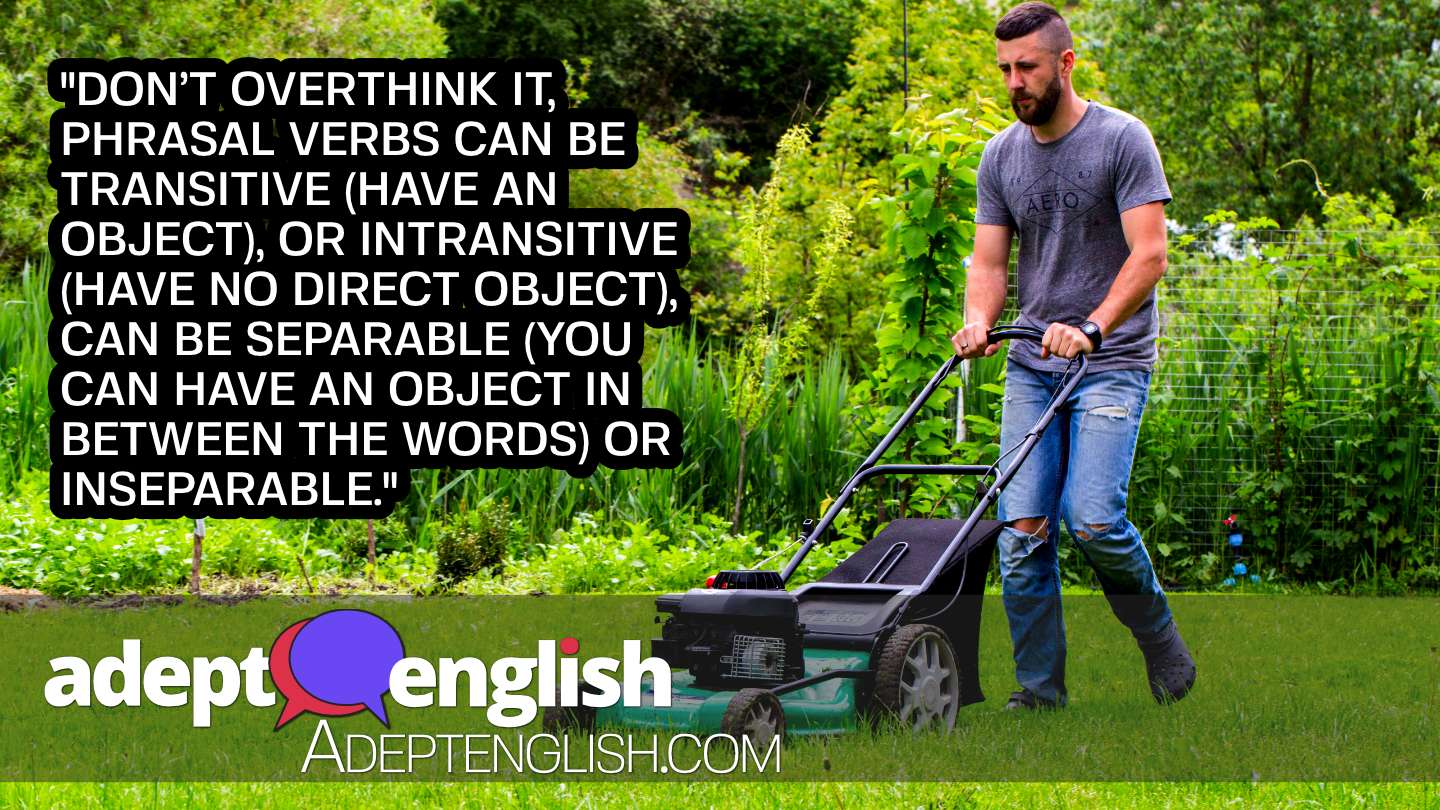Phrasal Verb Word Order
Today we talk about phrasal verbs, which are simple enough when you understand what is going on. There are a few things you need to be careful of and then it’s just a matter of learning some everyday English phrases to help with your English conversation fluency.
At the end of the main lesson article on the website in the PS section you will find some helpful tips.
Take a verb like ‘look’, simple enough, it’s what we do with our eyes. However, if we add another word (or words) to this verb for example we add the word ‘after’ to our verb ‘look’ it makes a new short phrasal verb ‘look after’ which means something different, it means ‘to care for something’.
There are several variations to this pattern, but basically you're taking a basic verb and by adding some words you are changing its meaning. But from a speaking and conversational point of view you need to watch out (<-spot the phrasal verb?) when your phrasal verb contains an object.
It’s all explained in the lesson so jump in and start listening.
Most Unusual Words:
Phrasal
Lawnmower
Overthink
Most common 2 word phrases:
| Phrase | Count |
|---|---|
| Phrasal Verb | 23 |
| Phrasal Verbs | 23 |
| To Take | 12 |
| The Object | 11 |
| An Object | 11 |
Listen To The Audio Lesson Now
The mp3 audio and pdf transcript for this lesson is now part of the Adept English back catalogue . You can still download and listen to this lesson as part of one of our podcast bundles.Transcript: Phrasal Verb Word Order Grammar Practice
Hi there and welcome to this Monday podcast from Adept English. I hope you’re enjoying our podcasts and that they are on a variety of topics to keep you interested. We certainly had interest last week in our podcast on the situation with Brexit. Some of you were keen to express your support for the EU. And last week, I wasn’t so much expressing support for Brexit as trying to look for some possible positive outcomes, if we do leave the EU.
Anyway, it’s a fast moving situation here in the UK at the moment. I’ll maybe give you an update in a few weeks time. Shall we do some grammar today instead?
Phrasal Verbs Need Special Attention
I’ve done podcasts in the past on phrasal verbs. Phrasal verbs are one of those areas which English language learners find difficult, so they are worth special attention. So what are phrasal verbs? A reminder is perhaps a good idea. A phrasal verb is where a verb is used with a preposition – so I’ve previously covered the different meanings of phrasal verbs like ‘to break down’, ‘to break in’, or ‘to break up’ - each one of these has more than one meaning. So the meaning of the verb ‘to break’ is still there with these words, but the preposition gives it an added meaning. I also did another podcast some time ago, where I looked at the meanings of ‘to take’ with prepositions, so again phrasal verbs, ‘to take after’, ‘to take apart’, ‘to take away’, ‘to take back’, ‘to take on’ etc.
Video
And these phrasal verbs are so frequently used, that it’s perhaps something I’ll do again in a future podcast – take a really common verb, and then run through how the meaning changes, when you add the preposition and make it a phrasal verb. Prepositions are of course words like on, at, in, out, down, through, off. But today, let’s have a look at word order with phrasal verbs. English speakers use phrasal verbs all the time – but they’re something which English language learners find difficult. And part of the reason is that the word order can be hard to learn. So let’s talk today about word order with phrasal verbs, when there’s an object.
Phrasal Verbs with an Object
So lots of phrasal verbs can be used with an object. So with the examples I’ve given you of phrasal verbs covered in previous podcasts – to take apart, to take away, to take on – these can all have an object. So here are some sentences with these verbs using an object (I’ll give you three sentences):-
On Saturday morning, he was taking apart the lawnmower and trying to mend it. (A lawnmower is the machine you use to cut the grass in your garden, by the way).
My sister picked up the suitcases and took them away. (Suitcases are what you put your clothes in, when you go on holiday. And the third sentence…)
I can take this work on, but not until Tuesday.
And Word Order with Phrasal Verbs with an Object
So what we’re focused on here, is word order – where the object goes in the sentence. So in the first sentence, ‘On Saturday morning, he was taking apart the lawnmower and trying to mend it.’, the phrasal verb is ‘to take apart’ - and you’ll notice that the object, here ‘the lawnmower’ is positioned after the preposition. ‘He was taking apart the lawnmower’. OK, so here the object follows the preposition, after the phrasal verb.
So what about the second sentence? ‘My sister picked up the suitcases and took them away.’ So two phrasal verbs here in one sentence. In the first part of the sentence, ‘My sister picked up the suitcases’ - the phrasal verb is ‘to pick up’ and the object is ‘the suitcases’. The object of the sentence, ‘the suitcases’ follows directly after the preposition – so again the same pattern as the first sentence. But then you’ll notice in the second part of the sentence ‘...and took them away’ - so that’s ‘[she] took them away’.
So here the pronoun ‘them’ (meaning the suitcases) is the object of this part of the sentence. And the word order? Well, ‘them’ is positioned between the verb and the preposition parts of the phrasal verb - ‘took them away’. So that’s different. So what’s the rule here? Is it that when the object is a pronoun, it sits between the phrasal verb and its preposition – and when the object is a noun, it comes after both parts of the phrasal verb?
Well, let’s look at the third sentence first. The third sentence was ‘I can take this work on, but not until Tuesday.’ Ah, OK. So here the phrasal verb is ‘to take on’. But you’ll notice that the object of the sentence, ‘this work’ is sitting in between the phrasal verb and its preposition. And ‘this work’ isn’t a pronoun, it’s a noun. So what is the correct rule here, because it feels a bit confusing?
📷
A photograph of a man holding a baby you cannot tell the gender of the baby. Used to help explain English grammar she, he and they.
Well, you might notice which combination I’ve missed out. And this will give you an idea of what the rule is. If I said ‘Oh, yes the lawnmower? On Saturday morning, he was taking it apart’ - that would be fine. But if I said ‘Oh yes, the lawnmower? On Saturday morning, he was taking apart it’, that would be incorrect. English speakers would understand what you meant, but it would be a grammar error and it sounds really wrong, it sounds really funny to us.
The Rule for Phrasal Verbs with an Object
So the rule is as follows:-
Noun objects of phrasal verbs may or may not be separated (so...he called the party off or he called off the party, both are fine), but pronoun objects must be separated (he called it off, but you can’t say he called off it).
So again, just to let you hear the pattern, let’s say those examples quickly again:-
- On Saturday morning, he was taking apart the lawnmower and trying to mend it. Or you could say ‘On Saturday morning, he was taking the lawnmower apart’ or you could say ‘On Saturday morning, he was taking it apart’. But what you can’t say is ‘On Saturday morning, he was taking apart it’. That one’s wrong!
The next one:-
- My sister picked up the suitcases and took them away. Or ‘My sister picked the suitcases up and took them away.’ But what you can’t say is ‘My sister picked the suitcases up and took away them.’
Are you getting it? One more:-
- ‘I can take this work on, but not until Tuesday.’ Or ‘I can take on this work, but not until Tuesday’. Or even ‘I can take it on, but not until Tuesday’. But what would be incorrect ‘I can take on it, but not until Tuesday’. We wouldn’t say that.
OK – this is perhaps quite difficult to get a hold of? You might want to rerun the podcast at this point and listen again, before you do the practice bit, which comes next. [PAUSE]
Practice Exercises for Word Order of Phrasal Verbs with Objects
Just before we do the practice sentences, don’t forget if you like our podcasts, do you know that for a small charge, you can download Adept English podcasts to your mobile phone or your tablet fifty at a time? If you go to our website at adeptenglish.com, you’ll be able to do this very easily and quickly. It would take you a long time to download fifty, that’s 50 podcasts, one by one. But by popular request, we’ve put this facility there on the website for you. If you do this, wherever you are, you’ll always have some podcasts to listen to and your English will improve even faster!
Buy an Adept English Podcast Bundle
OK, so let’s do some practice sentences. What I’d like you do do with each of these sentences is practise changing the noun object of the sentence to the correct pronoun. And also make sure you put the object pronoun in the right place in the sentence. So I’ll do the first one with you.
- ‘Please can you break up these cardboard boxes?’ So you need to replace ‘cardboard boxes’ which is the object of this phrasal verb, with the correct pronoun. The phrasal verb her is ‘to break up’. And you need to make sure that you’ve got the word order correct.
So ‘these cardboard boxes’? Well, the correct object pronoun will be ‘them’. So ‘Please can you break up these cardboard boxes?’ becomes ‘Please can you break them up?’ So the ‘them’ must come between the phrasal verb and its preposition.
So do the same thing with these sentences. You might want to pause as you do it in your head or you say it out loud, after each sentence.
- The students wrote down the correct words. (I’ll say each one twice).
- I am going to take my coat off.
- Please can you turn the lights out when you leave the room?
- Let me think over this problem before I decide. (and the last one)
- Can you please pick those books up off the floor? [Can you please pick up those books off the floor?]
[Answers are in the PDF transcript which you can download for free]
Download The Podcast Audio & Transcript
Goodbye
OK. Go to the transcript to find the answers and see whether you got them right. It’s just practice – it’s much easier to learn this through listening and maybe you’ll get to the stage, where it sounds incorrect to you too, if someone gets it wrong.
Enough for now. Have a lovely day. Speak to you again soon. Goodbye.







